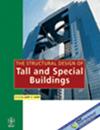Effect of concrete edge distance on the hysteretic response of roof joint
IF 1.3
3区 工程技术
Q3 CONSTRUCTION & BUILDING TECHNOLOGY
引用次数: 0
Abstract
Roof joint connects the upper roof structure to the lower RC columns in large‐span structures. However, during several earthquakes, concrete edge failure of roof joint observed in several previous earthquakes shows potential collapse damage of the large‐span structures. This paper presents an experimental and numerical study on the performance of roof joints under quasi‐static cyclic loading. The effects of concrete edge distance of anchor rods and using horizontally slotted holes in the base plate were investigated and discussed by means of ultimate shear resistances, failure modes, hysteretic responses, anchor strains, and stirrup strains. It was found that concrete edge failure was prone to occur if the edge distance was taken as per current design practice. However, with the use of slotted holes in the base plate, the concrete edge failure could be suppressed due to the sliding between the base plate and the mortar layer. A refined theoretical model was proposed to evaluate the ultimate shear resistance and predict the failure mode. Finite Element Models (FEMs) were also developed to verify the proposed theoretical model in terms of the ultimate shear resistance and the failure mode under both monotonic and cyclic loading.混凝土边距对屋面节点滞回响应的影响
在大跨度结构中,屋顶接缝将上部屋顶结构连接到下部RC柱。然而,在几次地震中,在前几次地震观测到的屋顶接缝混凝土边缘破坏表明,大跨度结构存在潜在的坍塌破坏。本文对屋顶节点在准静态循环荷载作用下的性能进行了实验和数值研究。从极限抗剪强度、破坏模式、滞回响应、锚应变和箍筋应变等方面,研究和讨论了锚杆混凝土边缘距离和底板上使用水平槽孔的影响。研究发现,如果按照当前设计实践计算边缘距离,则容易发生混凝土边缘破坏。然而,通过在底板上使用槽孔,可以抑制由于底板和砂浆层之间的滑动而导致的混凝土边缘破坏。提出了一个精细的理论模型来评估极限剪切阻力并预测破坏模式。还开发了有限元模型(FEM),以验证所提出的理论模型在单调和循环荷载下的极限剪切阻力和破坏模式。
本文章由计算机程序翻译,如有差异,请以英文原文为准。
求助全文
约1分钟内获得全文
求助全文
来源期刊
CiteScore
5.30
自引率
4.20%
发文量
83
审稿时长
6-12 weeks
期刊介绍:
The Structural Design of Tall and Special Buildings provides structural engineers and contractors with a detailed written presentation of innovative structural engineering and construction practices for tall and special buildings. It also presents applied research on new materials or analysis methods that can directly benefit structural engineers involved in the design of tall and special buildings. The editor''s policy is to maintain a reasonable balance between papers from design engineers and from research workers so that the Journal will be useful to both groups. The problems in this field and their solutions are international in character and require a knowledge of several traditional disciplines and the Journal will reflect this.
The main subject of the Journal is the structural design and construction of tall and special buildings. The basic definition of a tall building, in the context of the Journal audience, is a structure that is equal to or greater than 50 meters (165 feet) in height, or 14 stories or greater. A special building is one with unique architectural or structural characteristics.
However, manuscripts dealing with chimneys, water towers, silos, cooling towers, and pools will generally not be considered for review. The journal will present papers on new innovative structural systems, materials and methods of analysis.

 求助内容:
求助内容: 应助结果提醒方式:
应助结果提醒方式:


